Interoperable Semantic Systems in Public Administration: AI-Driven Data Mining from Law-Enforcement Reports
Abstract
1. Introduction
2. Materials and Methods
3. AI-Driven Data Extraction and Semantic-Web Construction
3.1. Knowledge Representation with Ontologies: Data, Information, Knowledge, and Wisdom
3.2. Semantic Web: Classes, Subclasses, Properties, Instances, and Data Information
3.3. Application Examples
- Classes and Subclasses:
- Class: “Incidents.” Subclasses: “Thefts,” “Burglaries,” “Vandalism.”
- Class: “Persons.” Subclasses: “Suspects,” “Witnesses,” “Police Officers.”
- Properties:
- Property “involvedΙn”: connecting a person with an incident.
- Property “locatedΙn”: connecting an incident with a location.
- Instances:
- For the subclass “Suspects”: Instance: “IoannisPapadopoulos.”
- For the subclass “Thefts”: Instance: “BicycleΤheftOn_20/10/2024.”
- Data Information:
- For the instance “IoannisPapadopoulos”:
- i
- Identification Number: “AB123456”
- ii
- Date of Birth: “15/07/1985”
- iii
- Address: “25_Irinis Street,_Thessaloniki.”
- For the instance “BicycleΤheftOn_20/10/2024”:
- i
- Location: “AristotelousSquare”
- ii
- Description: “Black_bicycle,_brand XYZ.”
- iii
- Case Reference Number: “CASE-20241020.”
- Semantic Linking:
- The incident “BicycleΤheftOn_20/10/2024” can be connected to the person “IoannisPapadopoulos” through the property “suspectedOf.”
- The location “AristotelousSquare” can be associated with other incidents, such as “Burglaries” in the same area, providing valuable operational data.
3.4. The Semantic Web as an Information System: Querying the Ontology
- Searching for incidents based on location:
- “Retrieve all incidents that occurred at Aristotelous Square.”
- SPARQL Query:
- SELECT ?incident WHERE {
- ?incident a :Incident.
- ?incident :located_in :Aristotelous_Square.
- }
- Searching for suspects related to a specific incident:
- “Which suspects are connected to the bicycle theft on 20/10/2024?”
- SPARQL Query:
- SELECT ?suspect WHERE {
- :Bicycle_Theft_20241020 :involves ?suspect.
- ?suspect a :Suspect.
- }
- Searching for time patterns in incidents:
- “Retrieve all incidents that occurred during nighttime hours”.
- SPARQL Query:
- SELECT ?incident WHERE {
- ?incident a :Incident.
- ?incident :time_period ?time.
- FILTER (?time >= “22:00”^^xsd:time && ?time <= “06:00”^^xsd:time)
- }
3.5. Use of Artificial-Intelligence Language Models for Data Extraction for Semantic Representation
| Police Control-Room Log—Initial Report (R1) |
| Date/time received: 7 January 2025, 23:50 h Handler: C/R Operator 4526—Metropolitan Police Service “This is Mr Daniel Carter, of 12 Hazelbrook Road, Brixton, SW2. I have noticed a silver hatchback with registration LC21 FZU parked outside 22 Hazelbrook Road, Brixton for several hours. It has not moved all evening and its hazard lights were flashing earlier. I do not recognise the vehicle and it is causing concern in the neighbourhood.” Action taken:
|
| Report ID | Title (Original Heading) | Author/Compiler | Type | Date–Time Recorded |
|---|---|---|---|---|
| R1 | Police Control-Room Log—Initial Report | C/R Operator 4526 (MPS) | Suspicious Vehicle | 7 January 2025, 23:50 |
| Person ID | Surname | First Name | Role |
|---|---|---|---|
| P01 | Carter | Daniel | Witness/caller |
| Address ID | Street Name | No. | Area/Postcode |
|---|---|---|---|
| A01 | Hazelbrook Rd | 12 | Brixton, SW2 |
| A02 | Hazelbrook Rd | 22 | Brixton, SW2 |
| Vehicle ID | Registration Plate |
|---|---|
| V01 | LC21 FZU |
| Incident ID | Date | Time | Description |
|---|---|---|---|
| I01 | 7 January 2025 | 23:50 | Suspicious parked vehicle outside 22 Hazelbrook Rd |
| Subject (Entity) | Object (Entity) | Property (Relation) |
|---|---|---|
| P01 | A01 | livesIn |
| P01 | I01 | reportedIncident |
| I01 | V01 | involvesVehicle |
| I01 | A02 | hasLocation |
| R1 | I01 | documentsIncident |
| R1 | P01 | hasReporter |
| R1 | V01 | mentionsVehicle |
| R1 | A02 | mentionsLocation |
| I01 | P01 | calledToPolice |
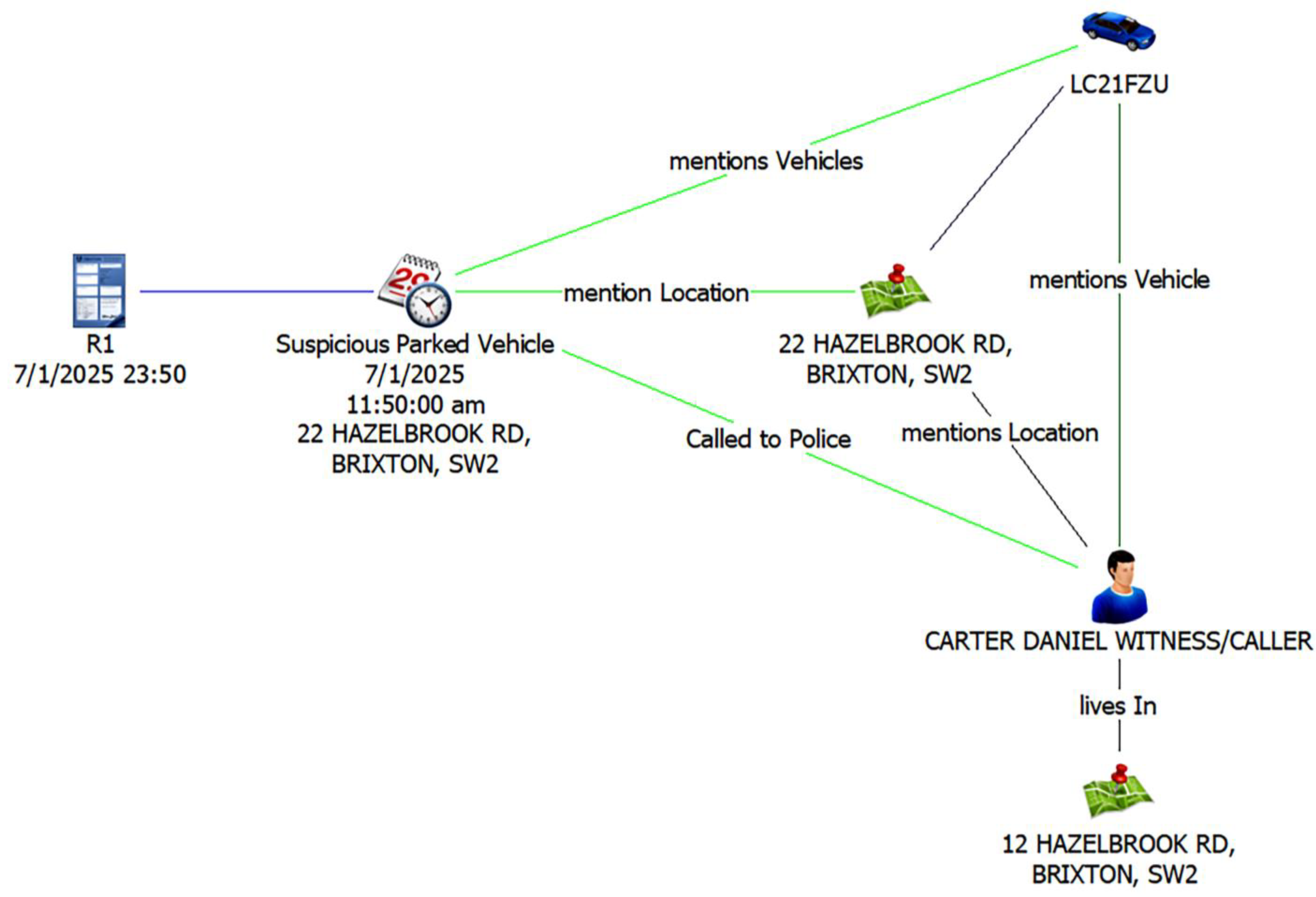
| Crime Report—Residential Burglary (R2) |
| Date/time reported: 7 January 2025, 09:00 h Reporting station: Brixton Police Station—front counter Officer taking statement: PC 3184 Roberts Mr Nicholas Peters, resident and owner of 22 Hazelbrook Road, Brixton, SW2, states that an unknown person gained entry to his home between approximately 23:00 h on 6 January and 07:30 h on 7 January 2025. The intruder removed assorted jewellery (estimated value GBP 3200) and an amount of cash (approximately GBP 450) from a bedroom drawer. No signs of forced entry were observed on the front door; rear kitchen window found unlatched. Action taken:
|
| Report ID | Title | Author/Compiler | Type | Date–Time Recorded |
|---|---|---|---|---|
| R2 | Crime Report—Residential Burglary | PC 3184 Roberts | Burglar | 7 January 2025, 09:00 |
| Person ID | Surname | First Name | Role |
|---|---|---|---|
| P02 | Peters | Nicholas | Victim/owner |
| Address ID | Street Name | No. | Area/Postcode |
|---|---|---|---|
| A02 | Hazelbrook Rd | 22 | Brixton, SW2 |
| Incident ID | Date Range | Description |
|---|---|---|
| I02 | 6 January 2025 23:00 → 7 January 2025 07:30 | Residential burglary at 22 Hazelbrook Rd; jewellery (GBP 3200) and cash (GBP 450) stolen |
| Subject (Entity) | Object (Entity) | Property (Relation) |
|---|---|---|
| P02 | A02 | livesIn |
| P02 | I02 | victimOfIncident |
| I02 | A02 | hasLocation |
| R2 | P02 | hasReporter |
| R2 | I02 | documentsIncident |
| R2 | A02 | mentionsLocation |

| Crime Report—Stolen Motor Vehicle (R3) |
| Date/time reported: 15 June 2024, 14:15 h Reporting station: Camden Town Police Station—front counter Officer taking statement: PC 2741 Hughes Mr Christopher Zacharias, holder of UK driving licence ZACHAR052901, resident at 48 Oakfield Terrace, Camden, NW1, reports the theft of his vehicle, a silver Ford Focus bearing registration LC21 FZU. The vehicle was last seen parked outside his home address at 22:30 h on 14 June 2024. At 07:45 h on 15 June it was discovered missing. No glass fragments or signs of forced entry were present at the scene. Vehicle details: Ford Focus Zetec, 2021 model, VIN ending …6734, fitted with factory alarm (status unknown). Action taken:
|
| Report ID | Title | Author/Compiler | Type | Date–Time Recorded |
|---|---|---|---|---|
| R3 | Crime Report—Stolen Motor Vehicle | PC 2741 Hughes | Vehicle theft | 15 June 2024, 14:15 |
| Person ID | Surname | First Name | Role |
|---|---|---|---|
| P03 | Zacharias | Christopher | Victim/owner |
| Address ID | Street Name | No. | Area/Postcode |
|---|---|---|---|
| A03 | Oakfield Terrace | 48 | Camden, NW1 |
| Vehicle ID | Registration Plate |
|---|---|
| V01 | LC21 FZU |
| Incident ID | Date Range | Description |
|---|---|---|
| I03 | 14 June 2024 22:30 → 15 June 2024 07:45 | Theft of vehicle LC21 FZU from 48 Oakfield Terrace, Camden |
| Subject (Entity) | Object (Entity) | Property (Relation) |
|---|---|---|
| P03 | A03 | livesIn |
| P03 | V01 | ownsVehicle |
| P03 | I03 | victimOfIncident |
| I03 | V01 | involvesVehicle |
| I03 | A03 | hasLocation |
| R3 | P03 | hasReporter |
| R3 | V01 | mentionsVehicle |
| R3 | I03 | documentsIncident |
| R3 | A03 | mentionsLocation |
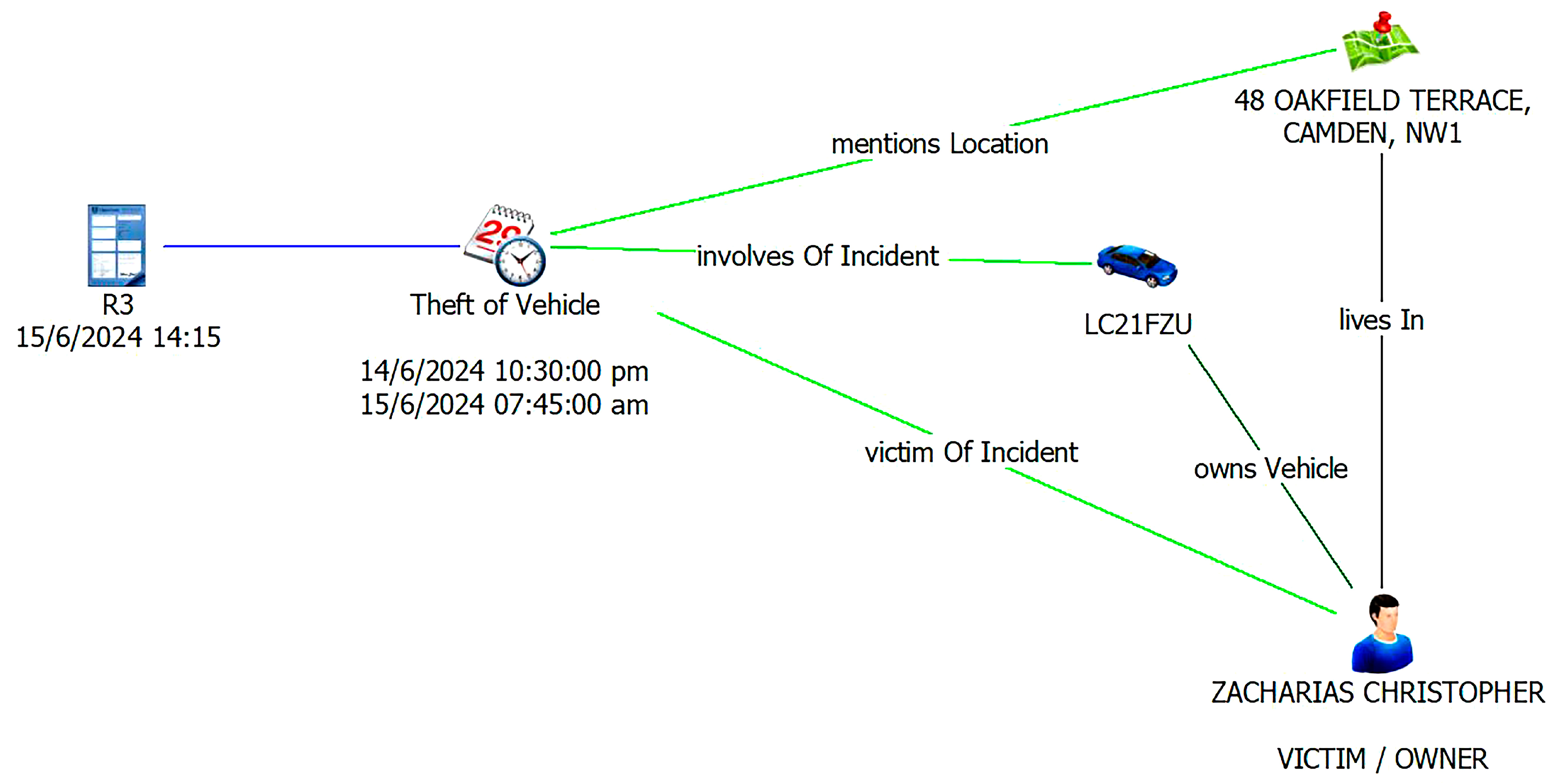
| Recovery Report—Abandoned Vehicle Located (R4) |
| Date/time located: 2 July 2025, 03:25 h Reporting unit: Response Team B, Southwark Borough—Unit QP14 Attending officers: Sgt 876 McAllister and PC 5628 Dean While conducting routine patrols, officers discovered a silver Ford Focus (registration LC21 FZU) abandoned beneath the railway bridge on 15 Riverbank Way, Bermondsey, SE16. The vehicle matched a Category A stolen marker issued on 15 June 2025 following a report by registered owner Mr Christopher Zacharias (Crime Ref 05/BRX/0125/2). No occupants were present; driver’s door found unlocked, ignition barrel intact, battery disconnected. The area was cordoned for forensic examination. Action taken:
|
| Report ID | Title | Author/Compiler (Unit) | Type | Date–Time Recorded |
|---|---|---|---|---|
| R4 | Recovery Report—Abandoned Vehicle | Response Team B/Unit QP14 | Vehicle recovery | 2 July 2025, 03:25 |
| Address ID | Street Name | No. | Area/Postcode |
|---|---|---|---|
| A04 | Riverbank Way | 15 | Bermondsey, SE16 |
| Vehicle ID | Registration Plate |
|---|---|
| V01 | LC21 FZU |
| Incident ID | Date | Description |
|---|---|---|
| I04 | 2 July 2025 3:25 | Abandoned stolen vehicle LC21 FZU found at 15 Riverbank Way |
| Subject (Entity) | Object (Entity) | Property (Relation) |
|---|---|---|
| I04 | V01 | involvesVehicle |
| I04 | A04 | hasLocation |
| R4 | V01 | mentionsVehicle |
| R4 | I04 | documentsIncident |
| R4 | A04 | MentionsLocation |
| V01 | A04 | foundIncident |
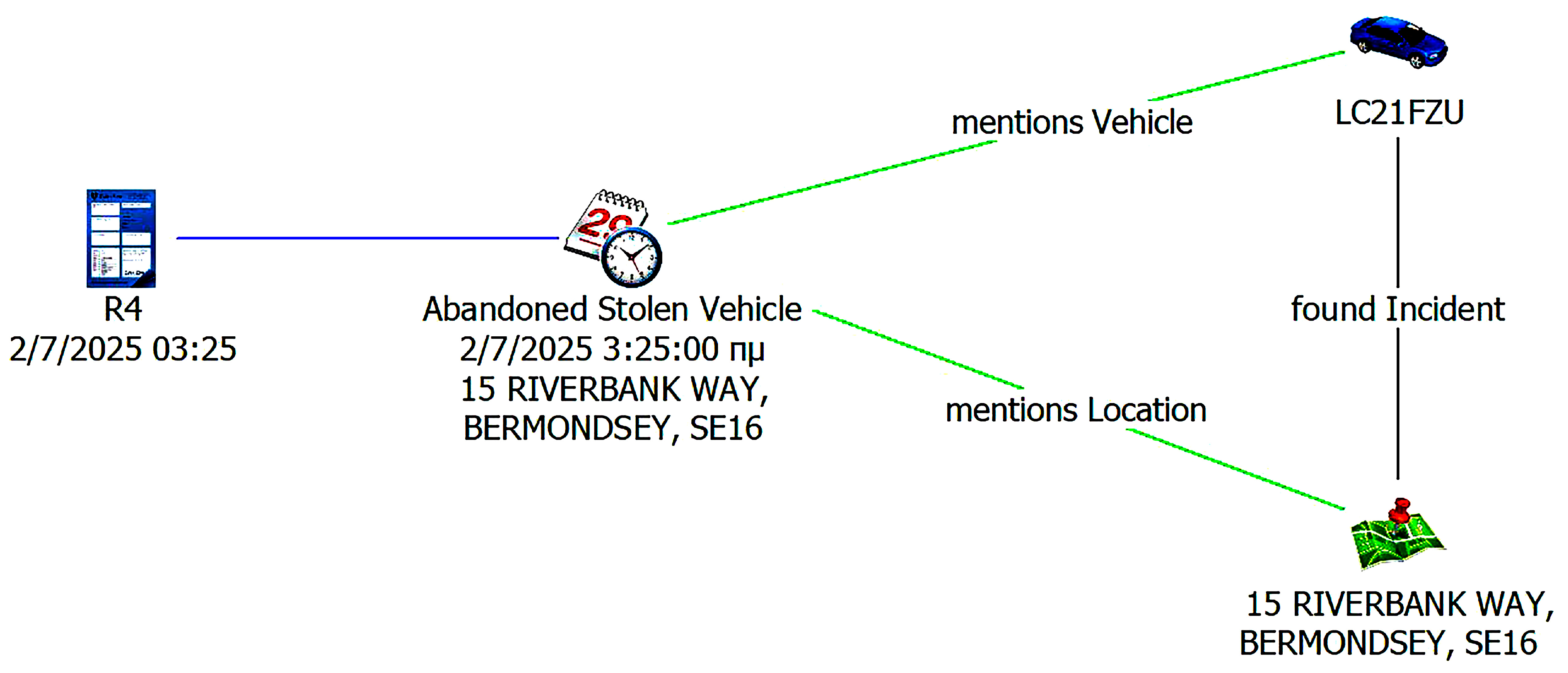
| Forensic Examination Report—Fingerprint Lift from Recovered Vehicle (R5) |
| Date/time examined: 2 July 2025, 09:40 h Scene reference: SOCO/3475/25 Examining officers: DC 1458 Malik (Fingerprint Bureau) and SOCO 772 Keane A detailed fingerprint examination was carried out on the silver Ford Focus, registration LC21 FZU, at the Met Impound Yard, Charlton, following recovery earlier the same day (incident R4). Two latent marks of evidential quality were developed and lifted from the interior driver-side door handle:
Action taken:
|
| Report ID | Title | Author/Compiler (Unit) | Type | Date–Time Recorded |
|---|---|---|---|---|
| R5 | Forensic Examination—Fingerprint Lift (Vehicle) | DC 1458 Malik and SOCO 772 Keane | Forensic examination | 2 July 2025 9:40 |
| Person ID | Surname | First Name | Role/Capacity |
|---|---|---|---|
| P03 | Zacharias | Christopher | Registered owner |
| Address ID | Facility/Street Name | No. | Area/Postcode |
|---|---|---|---|
| A05 | Met Impound Yard, Charlton | – | SE7 |
| Vehicle ID | Registration Plate |
|---|---|
| V01 | LC21 FZU |
| Table 26—Incident | ||
|---|---|---|
| Incident ID | Date-Time | Description |
| I05 | 2 July 2025 09:40 | Fingerprint examination of recovered vehicle LC21 FZU |
| Fingerprint ID | Status/Owner Link |
|---|---|
| FP-001 | Matches owner P03 (IDENT1 confirmed) |
| FP-002 | Unknown person—Category U (no match) |
| Subject (Entity) | Object (Entity) | Property (Relation) |
|---|---|---|
| I05 | V01 | involvesVehicle |
| I05 | A05 | hasLocation |
| FP-001 | P03 | belongsToPerson |
| FP-001 | I05 | foundInIncident |
| FP-002 | I05 | foundInIncident |
| R5 | I05 | documentsIncident |
| R5 | V01 | mentionsVehicle |
| R5 | A05 | mentionsLocation |
| R5 | P03 | mentionsPerson |
| R5 | FP-001 | mentionsFingerprint |
| R5 | FP-002 | mentionsFingerprint |

| Forensic Examination Report—Fingerprint Lift from Burglary Scene (R6) |
| Date/time examined: 7 January 2025, 10:00 h Scene reference: SOCO/1124/25 Location: 22 Hazelbrook Road, Brixton, SW2 Examining officers: DC 2197 Patel (Fingerprint Bureau) and SOCO 589 Turner Scene-of-crime officers attended the premises of burglary victim Mr Nicholas Peters (see Crime Ref 05/BRX/0125/25). Two usable latent fingerprints were developed on the inside frame of the rear kitchen window:
Action taken:
|
| Report ID | Title | Author/Compiler (Unit) | Type | Date–Time Recorded |
|---|---|---|---|---|
| R6 | Forensic Examination—Fingerprint Lift (Burglary Scene) | DC 2197 Patel and SOCO 589 Turner | Forensic examination | 7 January 2025 10:00 |
| Person ID | Surname | First Name | Role/Capacity |
|---|---|---|---|
| P02 | Peters | Nicholas | Victim/lawful occupant |
| Address ID | Street Name | No. | Area/Postcode |
|---|---|---|---|
| A02 | Hazelbrook Rd | 22 | Brixton, SW2 |
| Incident ID | Date-Time | Description |
|---|---|---|
| I06 | 7 January 2025 10:00 | Fingerprint examination of burglary scene at 22 Hazelbrook Rd (Crime Ref 05/BRX/0125/25) |
| Fingerprint ID | Status/Owner Link |
|---|---|
| FP-002 | Unknown person—Category U (previously lifted from vehicle LC21 FZU) |
| FP-003 | Matches victim P02 (IDENT1 confirmed) |
| Subject (Entity) | Object (Entity) | Property (Relation) |
|---|---|---|
| I06 | A02 | hasLocation |
| I06 | FP-003 | foundFingerprint |
| I06 | FP-002 | foundFingerprint |
| FP-003 | P02 | belongsToPerson |
| R6 | I06 | documentsIncident |
| R6 | A02 | mentionsLocation |
| R6 | P02 | mentionsPerson |
| R6 | FP-003 | mentionsFingerprint |
| R6 | FP-002 | mentionsFingerprint |
| P02 | A02 | livesIn |
| FP-002 | A02 | foundIncident |
| FP-003 | A02 | foundIncident |

| Fingerprint Identification Report—Match Notification (R7) |
| Date/time issued: 8 July 2025, 11:30 h Issuing unit: Metropolitan Police Fingerprint Bureau, Lambeth HQ Officer in charge: Sgt 4010 Gardiner (Senior Fingerprint Examiner) A routine IDENT1 search has produced a positive match for Fingerprint ID FP-002 (previously recorded as “Unknown Person—Category U”, see R5 and R6). The mark corresponds to the right-index impression of Mr Anthony Nikitas (DOB 19-04-1997, PNC ID NK-334-09). Nikitas’s reference set was captured on 5 February 2025 following an arrest in flagrante for attempted burglary at Flat 3, 27 Madeira Street, Islington, N1. The case was discontinued at court owing to insufficient evidence of intent; fingerprints nevertheless remain on file. Confidence level: 12 matching ridge characteristics confirmed by second examiner—conclusive (Grade A). Action recommended:
|
| Report ID | Title | Author/Compiler | Type | Date–Time Recorded |
|---|---|---|---|---|
| R7 | Fingerprint Identification—Match Alert | Sgt 4210 Gardiner | Fingerprint identification | 8 July 2025 11:30 |
| Person ID | Surname | First Name | Role/Capacity |
|---|---|---|---|
| P04 | Nikitas | Anthony | Suspect |
| Address ID | Street Name | No./Flat | Area/Postcode |
|---|---|---|---|
| A06 | Madeira Street | 27/Flat 3 | Islington, N1 |
| Incident ID | Date-Time | Description |
|---|---|---|
| I07 | 8 July 2025 11:30 | IDENT1 match: FP-002 to Anthony Nikitas (Grade A certainty) |
| Fingerprint ID | Status/Owner Link |
|---|---|
| FP-002 | Now matched to P04 Anthony Nikitas (IDENT1) |
| Subject (Entity) | Object (Entity) | Property (Relation) |
|---|---|---|
| FP-002 | P04 | belongsToPerson |
| FP-002 | I07 | matchedInIncident |
| I07 | A06 | hasLocation |
| R7 | I07 | documentsIncident |
| R7 | P04 | mentionsPerson |
| R7 | FP-002 | mentionsFingerprint |
| R7 | A06 | mentionsLocation |
| FP-002 | A06 | foundIncident |
| @prefix le: <http://example.org/le/>. @prefix rdf: <http://www.w3.org/1999/02/22-rdf-syntax-ns#>. @prefix owl: <http://www.w3.org/2002/07/owl#>. @prefix xsd: <http://www.w3.org/2001/XMLSchema#>. ### --- Classes --- le:Person rdf:type owl:Class. # Represents a person involved in a report le:Address rdf:type owl:Class. # Residential or incident location le:Vehicle rdf:type owl:Class. # Vehicle associated with the case ### --- Object-properties --- le:residesAt rdf:type owl:ObjectProperty ; # Person’s residence owl:domain le:Person ; owl:range le:Address. le:ownsVehicle rdf:type owl:ObjectProperty ; # Vehicle ownership owl:domain le:Person ; owl:range le:Vehicle. |
| SELECT ?incident WHERE { le:V01 le:involvesVehicle ?incident. le:FP-002 le:foundInIncident ?incident. } |
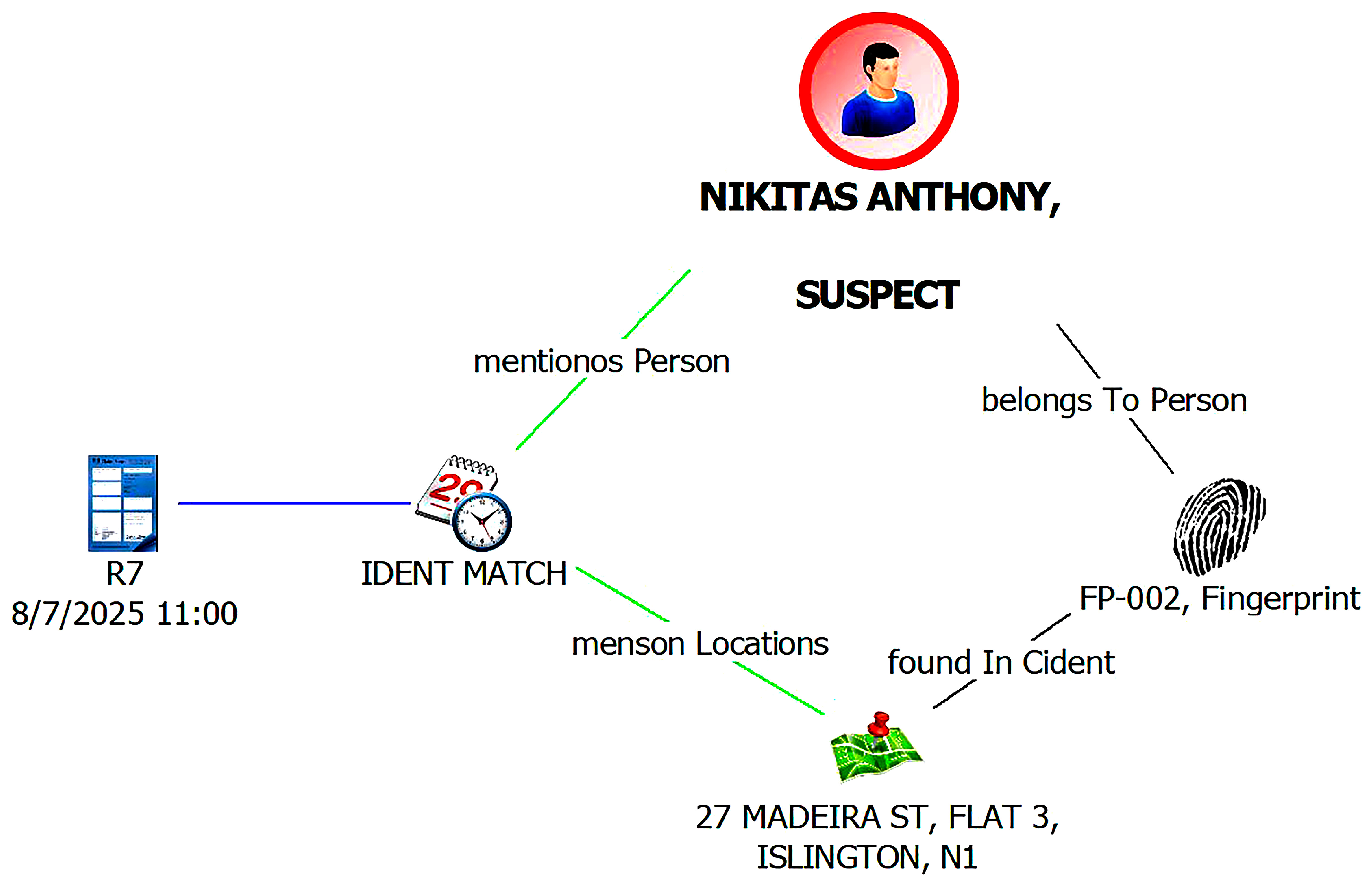
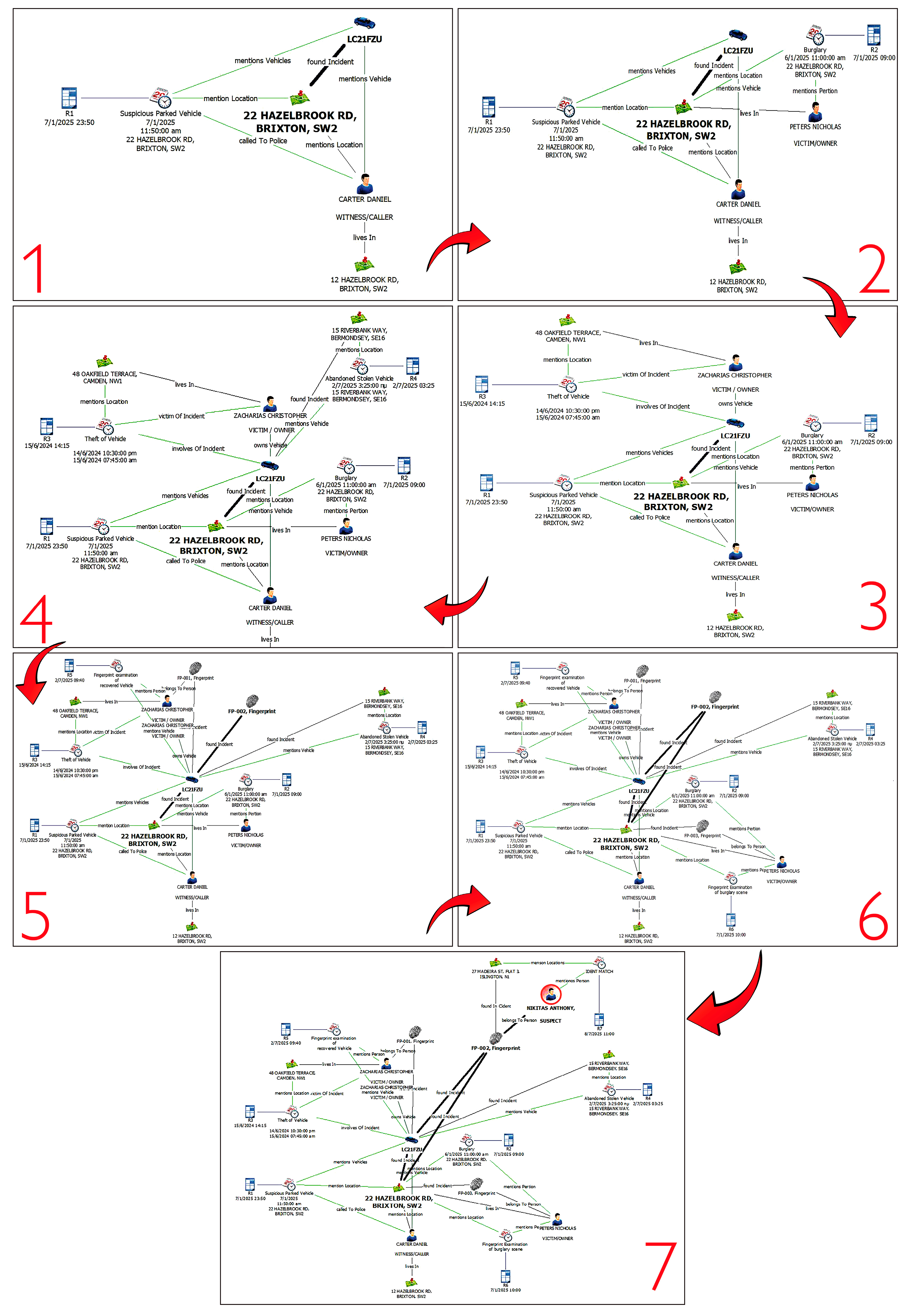
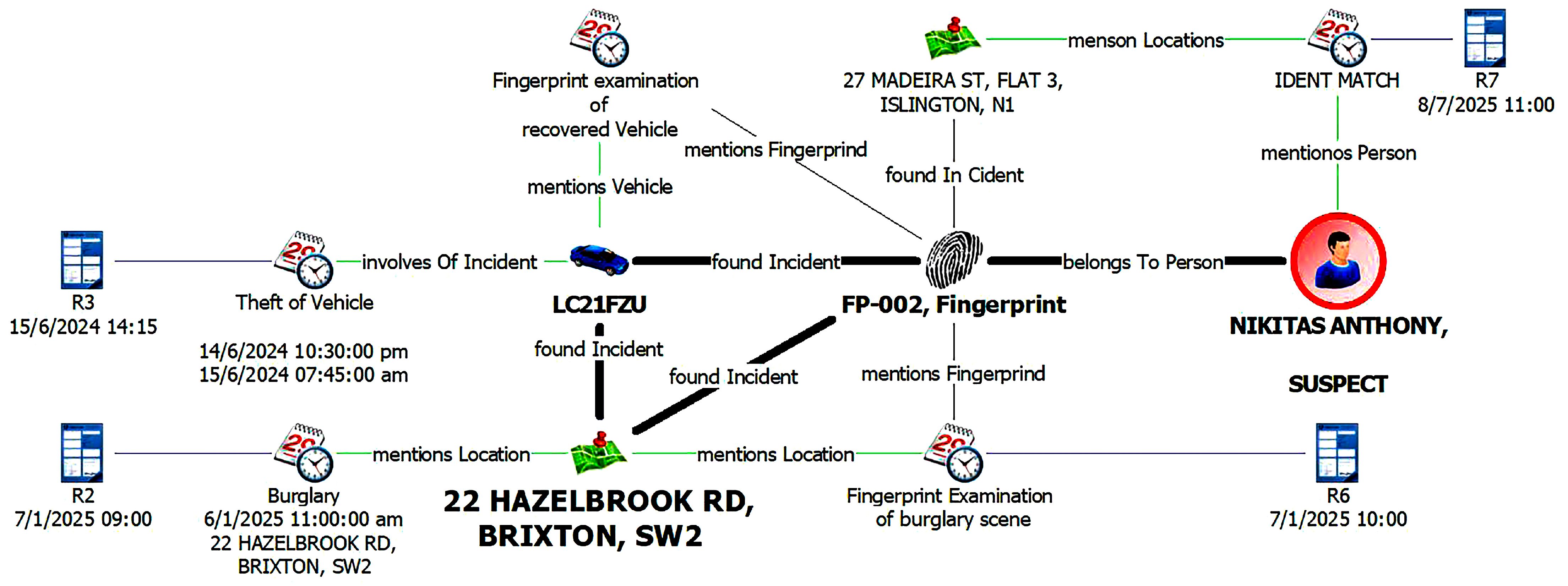
4. Discussion
Contribution and Comparative Advantage of the Proposed Method
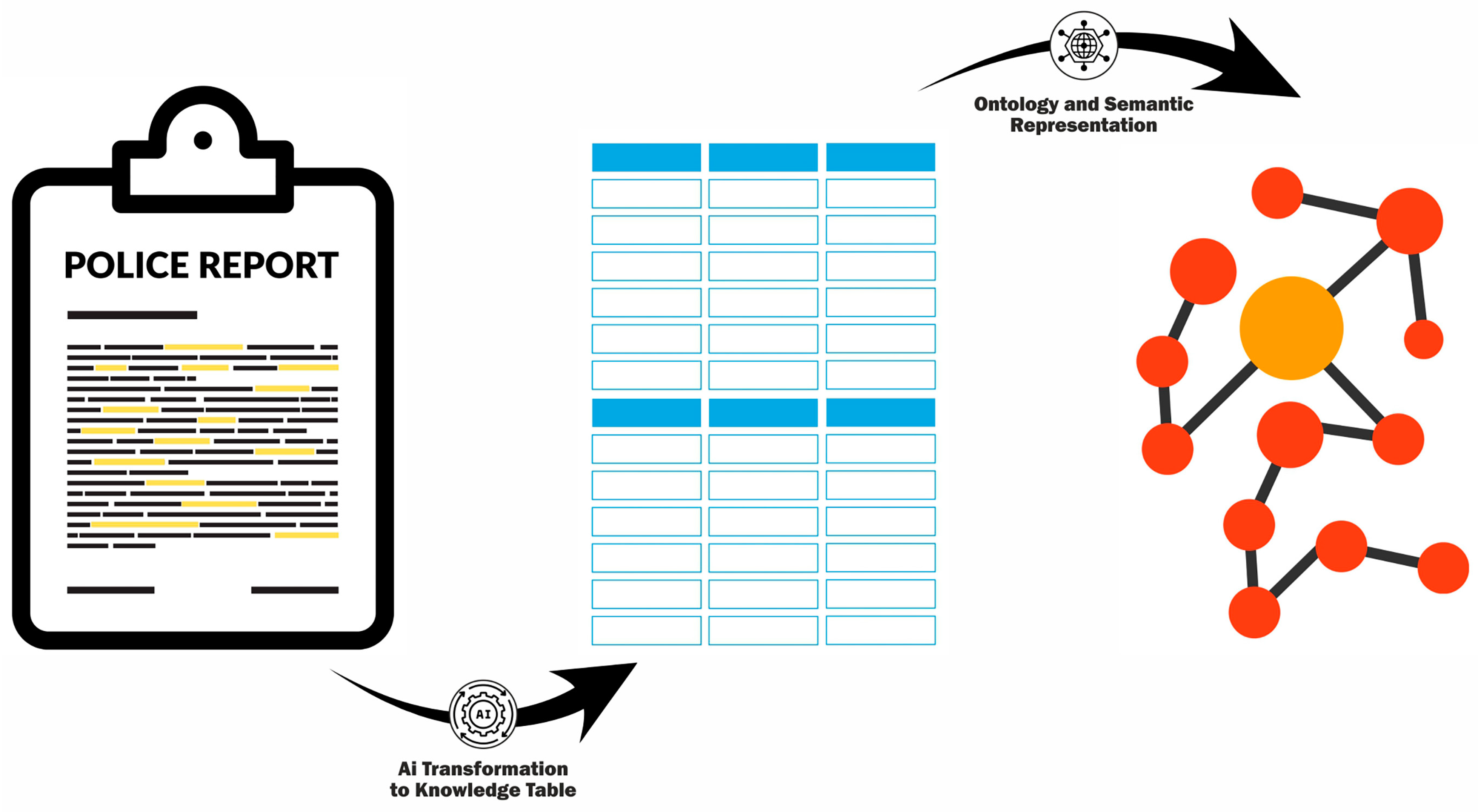
5. Conclusions
Supplementary Materials
Author Contributions
Funding
Data Availability Statement
Acknowledgments
Conflicts of Interest
References
- Wang, H.; Wang, S. A Semantic Model for Enterprise Digital Transformation Analysis. J. Comput. Inf. Syst. 2023, 63, 133–148. [Google Scholar] [CrossRef]
- Qurashi, A.W.; Holmes, V.; Johnson, A. Document Processing: Methods for Semantic Text Similarity Analysis. In Proceedings of the 2020 International Conference on INnovations in Intelligent SysTems and Applications (INISTA), Novi Sad, Serbia, 15–17 October 2020. [Google Scholar]
- Linxen, A.; Schmidt, V.-M.; Klinke, H.; Beecks, C. Ontology-Driven Knowledge Base for Digital Humanities: Restructuring Knowledge Organization at the Library of the Folkwang University of the Arts. In Proceedings of the 2024 IEEE International Conference on Big Data, Washington, DC, USA, 15–18 December 2024. [Google Scholar]
- Gammack, J.; Akay, H.; Ceylan, C.; Kim, S.-G. Semantic Knowledge Management System for Design Documentation with Heterogeneous Data Using Machine Learning. Procedia CIRP 2022, 109, 95–100. [Google Scholar] [CrossRef]
- Sateli, B.; Witte, R. Semantic Representation of Scientific Literature: Bringing Claims, Contributions and Named Entities onto the Linked Open Data Cloud. PeerJ Comput. Sci. 2015, 1, e37. [Google Scholar] [CrossRef]
- Boje, C.; Guerriero, A.; Kubicki, S.; Rezgui, Y. Towards a Semantic Construction Digital Twin: Directions for Future Research. Autom. Constr. 2020, 114, 103179. [Google Scholar] [CrossRef]
- Ciancarini, P.; Giancarlo, R.; Grimaudo, G. Digital Transformation in the Public Administrations: A Guided Tour for Computer Scientists. IEEE Access 2024, 12, 22841–22865. [Google Scholar] [CrossRef]
- Kalampokis, E.; Karacapilidis, N.; Tsakalidis, D.; Tarabanis, K. Understanding the Use of Emerging Technologies in the Public. Sector: A Review of Horizon 2020 Projects. Digit. Gov. Res. Pract. 2023, 4, 1–28. [Google Scholar] [CrossRef]
- Spyropoulos, A.Z.; Bratsas, C.; Makris, G.C.; Garoufallou, E.; Tsiantos, V. Interoperability-Enhanced Knowledge Management in Law Enforcement: An Integrated Data-Driven Forensic Ontological Approach to Crime Scene Analysis. Information 2023, 14, 607. [Google Scholar] [CrossRef]
- Spyropoulos, A.Z.; Kornilakis, A.; Makris, G.C.; Bratsas, C.; Tsiantos, V.; Antoniou, I. Semantic Representation of the Intersection of Criminal Law & Civil Tort. Data 2022, 7, 176. [Google Scholar] [CrossRef]
- Spyropoulos, A.Z.; Baliou, A.; Bratsas, C.; Garoufallou, E.; Tsiantos, V. Contemporary Semantic Search Techniques in Libraries: Research Gaps and Future Directions for Improving User Experience. In Proceedings of the Metadata and Semantic Research, Athens, Greece, 19–22 November 2024; Garoufallou, E., Sartori, F., Eds.; Springer Nature: Cham, Switzerland, 2024; pp. 169–178. [Google Scholar]
- Papadimitriou, N. Exploration of Knowledge Management Strategies of the Hellenic Police Central Intranet in Terms of an Integrated Knowledge Management Approach. Master’s Thesis, Linnaeus University, Växjö, Sweden, 2015. [Google Scholar]
- Kalogiannidis, S.; Paschalidou, M.; Kalfas, D.; Chatzitheodoridis, F. Relationship between Cyber Security and Civil Protection in the Greek Reality. Appl. Sci. 2023, 13, 2607. [Google Scholar] [CrossRef]
- Xanthopoulou, P.; Antoniadis, I.; Avlogiaris, G. Unveiling the Drivers of Digital Governance Adoption in Public Administration. Probl. Perspect. Manag. 2023, 21, 454–467. [Google Scholar] [CrossRef]
- Deligiannis, A.P.; Anagnostopoulos, D. Towards Open Justice: ICT Acceptance in the Greek Justice System the Case of the Integrated Court Management System for Penal and Civil Procedures (OSDDY/PP). In Proceedings of the 2017 Conference for E-Democracy and Open Government (CeDEM), Krems, Austria, 17–19 February 2017; pp. 82–91. [Google Scholar]
- Troulinos, E. Interoperability of Court Information Systems: The Case of the Integrated Case Management System for Administrative Justice (ICSAD-AD). Master’s Thesis, Interdepartmental Postgraduate Program in Law and Informatics. University of Macedonia, Thessaloniki, Greece, 2020. [Google Scholar]
- Stathopoulos, E.A.; Karageorgiadis, A.I.; Kokkalas, A.; Diplaris, S.; Vrochidis, S.; Kompatsiaris, I. A Query Expansion Benchmark on Social. Media Information Retrieval: Which Methodology Performs Best. and Aligns with Semantics? Computers 2023, 12, 119. [Google Scholar] [CrossRef]
- Kapantaidakis, I.; Perakakis, E.; Mastorakis, G.; Kopanakis, I. An Innovative Approach to Topic Clustering for Social Media and Web Data Using AI. Computers 2025, 14, 142. [Google Scholar] [CrossRef]
- Pavlidis, G. Agentic AI for Cultural Heritage: Embedding Risk Memory in Semantic Digital Twins. Computers 2025, 14, 266. [Google Scholar] [CrossRef]
- Theocharis, S.; Tsihrintzis, G.A. Semantic Web: The Evolution of the Web and the Opportunities for the e-Government. In Semantic Knowledge Modelling via Open Linked Ontologies: Ontologies in E-Governance; Theocharis, S., Tsihrintzis, G.A., Eds.; Springer International Publishing: Cham, Switzerland, 2023; pp. 51–123. ISBN 978-3-031-20585-9. [Google Scholar]
- Apoki, U.C. The Design of WASPEC: A Fully Personalised Moodle System Using Semantic Web Technologies. Computers 2021, 10, 59. [Google Scholar] [CrossRef]
- Samatas, M. Studying Surveillance in Greece: Methodological and Other Problems Related to an Authoritarian Surveillance Culture. Surveill. Soc. 2005, 3, 181–197. [Google Scholar] [CrossRef]
- Nagy, V. The Risks of Data Litter in Contemporary Policing Cultures: Interrogating Data Sharing Between Humanitarian NGOs and the Public Security Agencies. In Policing and Intelligence in the Global Big Data Era, Volume II: New Global Perspectives on the Politics and Ethics of Knowledge; Kuldova, T.Ø., Gundhus, H.O.I., Wathne, C.T., Eds.; Springer Nature: Cham, Switzerland, 2024; pp. 159–194. ISBN 978-3-031-68298-8. [Google Scholar]
- Makris, G.C.; Spyropoulos, A.Z.; Stamelos, I. Open-Source Software Development Communities: An Analysis Approach as a Social Network. In Proceedings of the Management of Digital EcoSystems, Naples, Italy, 18–20 November 2024; Chbeir, R., Benslimane, D., Zervakis, M., Manolopoulos, Y., Ngyuen, N.T., Tekli, J., Eds.; Springer Nature: Cham, Switzerland, 2024; pp. 193–202. [Google Scholar]
- Thompson, S.; Giles, N.; Li, Y.; Gharib, H.; Nguyen, T.D. Using AI and Semantic Web Technologies to Attack Process Complexity in Open Systems. In Proceedings of the Research and Development in Intelligent Systems XXIII, Cambridge, UK, 11–13 December 2006; Bramer, M., Coenen, F., Tuson, A., Eds.; Springer: London, UK, 2007; pp. 261–274. [Google Scholar]
- Lan, Q.; Wen, D.; Zhang, Z.; Zeng, Q.; Chen, X.; Popovski, P.; Huang, K. What is semantic communication? A view on conveying meaning in the era of machine intelligence. J. Commun. Inf. Netw. 2021, 6, 336–371. [Google Scholar] [CrossRef]
- Massari, H.E.; Gherabi, N.; Qanouni, F.; Mhammedi, S.; Amnai, M. The Role of Artificial Intelligence in the Semantic Web. In Proceedings of the 2024 10th International Conference on Optimization and Applications (ICOA), Almería, Spain, 17–18 July 2024; pp. 1–6. [Google Scholar]
- Graves, A. A Case Study for Integrating Public Safety Data Using Semantic Technologies. Inf. Polity 2011, 16, 261–275. [Google Scholar] [CrossRef]
- Elkhodr, M. Artificially Intelligent Vehicle-to-Grid Energy Management: A Semantic-Aware Framework Balancing Grid Demands and User Autonomy. Computers 2024, 13, 249. [Google Scholar] [CrossRef]
- Drăgoicea, M.; Léonard, M.; Ciolofan, S.N.; Militaru, G. Managing Data, Information, and Technology in Cyber Physical Systems: Public Safety as a Service and Its Systems. IEEE Access 2019, 7, 92672–92692. [Google Scholar] [CrossRef]
- Bountouri, L. Archives in the Digital Age: Standards, Policies and Tools; Chandos Publishing: Oxford, UK, 2017; ISBN 978-1-78063-458-6. [Google Scholar]
- Mavromati, E.; Stamatiou, E.; Chrysaeidis, L.; Astaras, K. Improving the Geometric Documentation of Cultural Heritage: Combined Methods for the Creation of an Integrated Management Information System in Greece. In Proceedings of the Transdisciplinary Multispectral Modeling and Cooperation for the Preservation of Cultural Heritage, Athens, Greece, 10–13 October 2018; Moropoulou, A., Korres, M., Georgopoulos, A., Spyrakos, C., Mouzakis, C., Eds.; Springer International Publishing: Cham, Switzerland, 2019; pp. 3–21. [Google Scholar]
- Alexopoulos, C.H. Open Government Data Infrastructures: Research Challenges, Artefacts Design and Evaluation. Ph.D. Thesis, University of the Aegean, Chios, Greece, 2016. [Google Scholar] [CrossRef]
- Beris, T.; Angelidis, I.; Chalkidis, I.; Nikolaou, C.; Papaloukas, C.; Soursos, P.; Koubarakis, M. Towards a Decentralized, Trusted, Intelligent and Linked Public Sector: A Report from the Greek Trenches. In Proceedings of the Companion Proceedings of the 2019 World Wide Web Conference, San Francisco, CA, USA, 13–17 February 2019; Association for Computing Machinery: New York, NY, USA, 2019; pp. 840–849. [Google Scholar]
- Alexopoulos, C.; Loukis, E.; Mouzakitis, S.; Petychakis, M.; Charalabidis, Y. Analysing the Characteristics of Open Government Data Sources in Greece. J. Knowl. Econ. 2018, 9, 721–753. [Google Scholar] [CrossRef]
- van den Hoogen, J.; Bloemheuvel, S.; Atzmueller, M. Advanced Analytics on Complex Industrial Data. In Data Science for Entrepreneurship: Principles and Methods for Data Engineering, Analytics, Entrepreneurship, and the Society; Liebregts, W., van den Heuvel, W.-J., van den Born, A., Eds.; Springer International Publishing: Cham, Switzerland, 2023; pp. 177–203. ISBN 978-3-031-19554-9. [Google Scholar]
- Kavouras, M.; Kokla, M. Theories of Geographic Concepts: Ontological Approaches to Semantic Integration; CRC Press: Boca Raton, FL, USA, 2007; ISBN 978-0-429-12928-5. [Google Scholar]
- Molina, B.; Palau, C.E.; Calvo-Gallego, J. Enriching Earth Observation Datasets through Semantics for Climate Change Applications: The EIFFEL Ontology. Open Res. Eur. 2024, 4, 133. [Google Scholar] [CrossRef] [PubMed]
- Coreynen, W.; Pier van Gosliga, S. Digital Servitization in Agriculture. In Data Science for Entrepreneurship: Principles and Methods for Data Engineering, Analytics, Entrepreneurship, and the Society; Liebregts, W., van den Heuvel, W.-J., van den Born, A., Eds.; Springer International Publishing: Cham, Switzerland, 2023; pp. 331–351. ISBN 978-3-031-19554-9. [Google Scholar]
- Cascavilla, G.; Dalla Palma, S.; Driessen, S.; van den Heuvel, W.-J.; De Pascale, D.; Sangiovanni, M.; Schouten, G. Data Engineering in Action. In Data Science for Entrepreneurship: Principles and Methods for Data Engineering, Analytics, Entrepreneurship, and the Society; Liebregts, W., van den Heuvel, W.-J., van den Born, A., Eds.; Springer International Publishing: Cham, Switzerland, 2023; pp. 77–97. ISBN 978-3-031-19554-9. [Google Scholar]
- Kumara, I.; Kayes, A.S.M.; Mundt, P.; Schneider, R. Data Governance. In Data Science for Entrepreneurship: Principles and Methods for Data Engineering, Analytics, Entrepreneurship, and the Society; Liebregts, W., van den Heuvel, W.-J., van den Born, A., Eds.; Springer International Publishing: Cham, Switzerland, 2023; pp. 37–62. ISBN 978-3-031-19554-9. [Google Scholar]
- Van Den Heuvel, W.-J.; Liebregts, W.; Van Den Born, A. Data Science for Entrepreneurship: Principles and Methods for Data Engineering, Analytics, Entrepreneurship, and the Society; Liebregts, W., Van Den Heuvel, W.-J., Van Den Born, A., Eds.; Classroom Companion: Business; Springer International Publishing: Cham, Switzerland, 2023; ISBN 978-3-031-19553-2. [Google Scholar]
- Buijsse, R.; Willemsen, M.; Snijders, C. Data-Driven Decision-Making. In Data Science for Entrepreneurship: Principles and Methods for Data Engineering, Analytics, Entrepreneurship, and the Society; Liebregts, W., van den Heuvel, W.-J., van den Born, A., Eds.; Springer International Publishing: Cham, Switzerland, 2023; pp. 239–277. ISBN 978-3-031-19554-9. [Google Scholar]
- Schouten, G.; Arena, G.; van Leeuwen, F.; Heck, P.; Mulder, J.; Aalbers, R.; Leenders, R.; Böing-Messing, F. Data Analytics in Action. In Data Science for Entrepreneurship: Principles and Methods for Data Engineering, Analytics, Entrepreneurship, and the Society; Liebregts, W., van den Heuvel, W.-J., van den Born, A., Eds.; Springer International Publishing: Cham, Switzerland, 2023; pp. 205–233. ISBN 978-3-031-19554-9. [Google Scholar]
- Tamburri, D.; van den Heuvel, W.-J. Big Data Engineering. In Data Science for Entrepreneurship: Principles and Methods for Data Engineering, Analytics, Entrepreneurship, and the Society; Liebregts, W., van den Heuvel, W.-J., van den Born, A., Eds.; Springer International Publishing: Cham, Switzerland, 2023; pp. 25–35. ISBN 978-3-031-19554-9. [Google Scholar]
- Garriga, M.; Monsieur, G.; Tamburri, D. Big Data Architectures. In Data Science for Entrepreneurship: Principles and Methods for Data Engineering, Analytics, Entrepreneurship, and the Society; Liebregts, W., van den Heuvel, W.-J., van den Born, A., Eds.; Springer International Publishing: Cham, Switzerland, 2023; pp. 63–76. ISBN 978-3-031-19554-9. [Google Scholar]
- Sieber, S.; Henrich, A. Knowledge Management for Hybrid Learning. In Organizational Learning and Knowledge: Concepts, Methodologies, Tools and Applications; IGI Global Scientific Publishing: London, UK, 2012; pp. 1956–1980. ISBN 978-1-60960-783-8. [Google Scholar]
- Kruijswijk, J.; van Emden, R.; Kaptein, M. Sequential Experimentation and Learning. In Data Science for Entrepreneurship: Principles and Methods for Data Engineering, Analytics, Entrepreneurship, and the Society; Liebregts, W., van den Heuvel, W.-J., van den Born, A., Eds.; Springer International Publishing: Cham, Switzerland, 2023; pp. 147–175. ISBN 978-3-031-19554-9. [Google Scholar]
- Spyropoulos, A.Z.; Ioannidis, E.; Antoniou, I. Interoperability and Targeted Attacks on Terrorist Organizations Using Intelligent Tools from Network Science. Information 2023, 14, 580. [Google Scholar] [CrossRef]
- Spyropoulos, A.Z.; Kissoudi, N.; Samalis, A.; Makris, G.C. Representation in the Semantic Web of the Structure and Functions of a Police Department in Greece. Int. J. Eng. Sci. Invent. 2020, 9, 1–6. [Google Scholar]
- Spyropoulos, A.Z.; Bratsas, C.; Makris, G.C.; Ioannidis, E.; Tsiantos, V.; Antoniou, I. Entropy and Network Centralities as Intelligent Tools for the Investigation of Terrorist Organizations. Entropy 2021, 23, 1334. [Google Scholar] [CrossRef]
- Masa, P.; Kintzios, S.; Vasileiou, Z.; Meditskos, G.; Vrochidis, S.; Kompatsiaris, I. A Semantic Framework for Decision Making in Forest Fire Emergencies. Appl. Sci. 2023, 13, 9065. [Google Scholar] [CrossRef]
- Bania, A.; Iatrellis, O.; Samaras, N.; Panagiotakopoulos, T. FiReS: A Semantic Model for Advanced Querying and Prediction Analysis for First Responders in Post-Disaster Response Plans. Int. J. Disaster Risk Reduct. 2024, 109, 104592. [Google Scholar] [CrossRef]
- Spyropoulos, A.Z.; Bratsas, C.; Makris, G.C.; Ioannidis, E.; Tsiantos, V.; Antoniou, I. Investigation of Terrorist Organizations Using Intelligent Tools: A Dynamic Network Analysis with Weighted Links. Mathematics 2022, 10, 1092. [Google Scholar] [CrossRef]
- Bratsas, C.; Anastasiadis, E.K.; Angelidis, A.K.; Ioannidis, L.; Kotsakis, R.; Ougiaroglou, S. Knowledge Graphs and Semantic Web Tools in Cyber Threat Intelligence: A Systematic Literature Review. J. Cybersecurity Priv. 2024, 4, 518–545. [Google Scholar] [CrossRef]
- Pliatsios, A.; Lymperis, D.; Goumopoulos, C. S2NetM: A Semantic Social Network of Things Middleware for Developing Smart and Collaborative IoT-Based Solutions. Future Internet 2023, 15, 207. [Google Scholar] [CrossRef]
- Rizer, A.; Watney, C. Artificial Intelligence Can Make Our Jail System More Efficient, Equitable, and Just. Tex. Rev. Pol. 2018, 23, 181. [Google Scholar] [CrossRef]
- Campbell, R.W. Artificial Intelligence in the Courtroom: The Delivery of Justice in the Age of Machine Learning. Colo. Tech. LJ 2020, 18, 323. [Google Scholar] [CrossRef]
- Encoding Ontology/Greek Ministry of Interior. Available online: http://www.opengov.gr/ypes/?p=3885 (accessed on 5 January 2021).
- Benjamins, V.R.; Casanovas, P.; Breuker, J.; Gangemi, A. Law and the Semantic Web: Legal Ontologies, Methodologies, Legal Information Retrieval, and Applications; Springer: Berlin/Heidelberg, Germany, 2005; Volume 3369, ISBN 3-540-32253-1. [Google Scholar]
- Van Engers, T.; Boer, A.; Breuker, J.; Valente, A.; Winkels, R. Ontologies in the Legal Domain. In Digital Government: E-Government Research, Case Studies, and Implementation; Springer: Berlin/Heidelberg, Germany, 2008; pp. 233–261. [Google Scholar]
- Sadri McCampbell, A.; Moorhead Clare, L.; Howard Gitters, S. Knowledge Management: The New Challenge for the 21st Century. J. Knowl. Manag. 1999, 3, 172–179. [Google Scholar] [CrossRef]
- Spyropoulos, A. Study of Complex Systems with Tools of Network Theory: Application: Analysis of Networks of Terrorist Organizations. Ph.D. Thesis, Democritus University of Thrace (DUTH), Komotini, Greece, 2024. [Google Scholar]
- Kurniawan, S.; Sarah, Y.S. Integrating Semantic Web and AI in Informatics Education to Enhance Digital Information Evaluation Skills. J. Sustain. Innov. Eng. 2025, 1, 16–19. [Google Scholar] [CrossRef]
- Ong, J.C.L.; Seng, B.J.J.; Law, J.Z.F.; Low, L.L.; Kwa, A.L.H.; Giacomini, K.M.; Ting, D.S.W. Artificial Intelligence, ChatGPT, and Other Large Language Models for Social Determinants of Health: Current State and Future Directions. Cell Rep. Med. 2024, 5, 101356. [Google Scholar] [CrossRef]
- Shen, H. A Semantic-Aware Attribute-Based Access Control Model for Web Services. In Proceedings of the Algorithms and Architectures for Parallel Processing, Taipei, Taiwan, 8–11 June 2009; Hua, A., Chang, S.-L., Eds.; Springer: Berlin, Heidelberg, 2009; pp. 693–703. [Google Scholar]
- Sadeghi, M.; Sartor, L.; Rossi, M. A Semantic-Based Access Control Approach for Systems of Systems. SIGAPP Appl. Comput. Rev. 2022, 21, 5–19. [Google Scholar] [CrossRef]
- ISO/IEC 27001:2022; Information Security, Cybersecurity and Privacy Protection—Information Security Management Systems —Requirements. International Organization for Standardization: Geneva, Switzerland, 2022.
- ISO/IEC 27701:2019; Security Techniques—Extension to ISO/IEC 27001 and ISO/IEC 27002 for Privacy Information Management—Requirements and Guidelines. International Organization for Standardization: Geneva, Switzerland, 2019.
- OWASP Top 10:2021; The Ten Most Critical Web Application Security Risks. OWASP Foundation: Wilmington, DE, USA, 2021. Available online: https://owasp.org/Top10/ (accessed on 4 September 2025).
- Badawy, W. Data-Driven Framework for Evaluating Digitization and Artificial Intelligence Risk: A Comprehensive Analysis. AI Ethics 2023, 5, 453–478. [Google Scholar] [CrossRef]
- Carayannis, E.G.; Askounis, D.; Andoutropoulou, M.; Zotas, N. Leveraging AI for Enhanced eGovernment: Optimizing the Use of Open Governmental Data. J. Knowl. Econ. 2024, 15, 1–36. [Google Scholar] [CrossRef]
- Rane, N. ChatGPT and Similar Generative Artificial Intelligence (AI) for Building and Construction Industry: Contribution, Opportunities and Challenges of Large Language Models for Industry 4.0, Industry 5.0, and Society 5.0. ResearchGate, 2023. Available online: https://www.researchgate.net/publication/375192472 (accessed on 4 September 2025).
- Taj, M.; Brenner, M.; Sulaiman, Z.; Pandian, V. Sepsis Protocols to Reduce Mortality in Resource-Restricted Settings: A Systematic Review. Intensive Crit. Care Nurs. 2022, 72, 103255. [Google Scholar] [CrossRef] [PubMed]
Disclaimer/Publisher’s Note: The statements, opinions and data contained in all publications are solely those of the individual author(s) and contributor(s) and not of MDPI and/or the editor(s). MDPI and/or the editor(s) disclaim responsibility for any injury to people or property resulting from any ideas, methods, instructions or products referred to in the content. |
© 2025 by the authors. Licensee MDPI, Basel, Switzerland. This article is an open access article distributed under the terms and conditions of the Creative Commons Attribution (CC BY) license (https://creativecommons.org/licenses/by/4.0/).
Share and Cite
Spyropoulos, A.Z.; Tsiantos, V. Interoperable Semantic Systems in Public Administration: AI-Driven Data Mining from Law-Enforcement Reports. Computers 2025, 14, 376. https://doi.org/10.3390/computers14090376
Spyropoulos AZ, Tsiantos V. Interoperable Semantic Systems in Public Administration: AI-Driven Data Mining from Law-Enforcement Reports. Computers. 2025; 14(9):376. https://doi.org/10.3390/computers14090376
Chicago/Turabian StyleSpyropoulos, Alexandros Z., and Vassilis Tsiantos. 2025. "Interoperable Semantic Systems in Public Administration: AI-Driven Data Mining from Law-Enforcement Reports" Computers 14, no. 9: 376. https://doi.org/10.3390/computers14090376
APA StyleSpyropoulos, A. Z., & Tsiantos, V. (2025). Interoperable Semantic Systems in Public Administration: AI-Driven Data Mining from Law-Enforcement Reports. Computers, 14(9), 376. https://doi.org/10.3390/computers14090376











